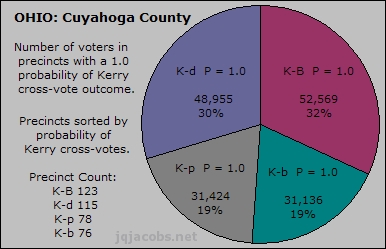Edited on Mon May-26-08 05:03 PM by L. Coyote
What is a matching analysis? In my graduate-level quantitative methods instruction, that term was not used for this type of inquiry. If you mean optimal matching analysis, isn't that sequence analysis? I do not see how it would be applied to voting fraud. I think you are referring to paired analysis, which is employed in
How Kerry Votes Were Switched to Bush Votes in several ways. In fact, pairing is important because cross-voting happens when precincts are paired. The analysis also accounts for pairing in comparing precincts at the same locations, and in probability sorting those precincts. The pairing of specific probability outcomes is even discussed. This graphic illustrates which probabilities are paired.

Have you read
How Kerry Votes Were Switched to Bush Votes? Here is another excerpt:
A t-test quantifies difference in a standardized, easy-to-compare, probability format. A paired t-test of all 1,255 cross-voting precincts indicates an astounding 0.862 probability Peroutka and Badnarik voters are the same population. The actual probability so many voters for different candidates test probable as the same populations is infinitely miniscule. The test results positive with such high probability because the Peroutka and Badnarik vote patterns are largely the same population, Kerry cross-voters. Kerry cross-votes counted as Peroutka and Badnarik votes out weights their actual vote patterns. For every K-b precinct, an adjacent precinct cross-votes K-p, and at locations where one precinct cross-votes, this unusual application of a t-test evidences the other is likely doing so also. T-tests comparing location-paired precinct data reinforce evidence of a strong correlation between locations and Kerry to third-party cross-voting.
T-tests applied to Kerry and Bush vote results in Table 20 and Table 22 support the evidence of Kerry-Bush vote-switching. T-test results and more subset comparisons are highlighted in the spreadsheets.
Have you done graduate studies in quantitative methods? If so, you must realize how robust n = 1,255 is.
Can you read spreadsheets and use Excel? There is a lot more there, including paired t-testing.